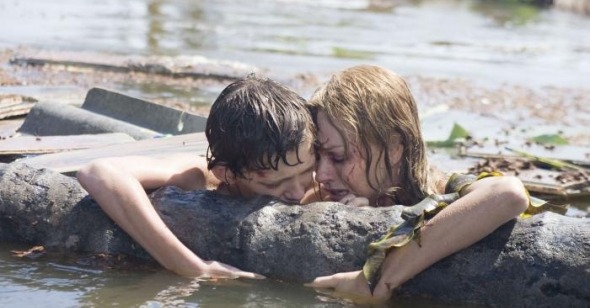In the Weeds
by Caroline McKenzie
The Impossible
Dir. J.A. Bayona, Spain, Summit Entertainment
The Impossible—Spanish director J.A. Bayona’s fictionalized account of one family’s survival in the midst of the Indian Ocean tsunami of 2004—begins with the ominous rumble of an airplane ferrying Maria (Naomi Watts), Henry (Ewan McGregor), and their three sons on a family holiday to Thailand. Turbulence on the plane—foreshadowing the natural disaster that we know is coming—causes a page to drop from Maria’s book, revealing that her choice in vacation reading is the work of Joseph Conrad.
If Bayona’s intent in this opening sequence is to highlight Conrad’s psychological realism to indicate what viewers should expect from his film, it is not without reason—watching The Impossible is often a vivid, harrowing experience. But it also, perhaps unintentionally, highlights that, like much of Conrad’s work, The Impossible is very specifically about white people wandering into native communities.
It isn’t necessarily unforgivable that the film tells the story of a tsunami that decimated Southeast Asia through the lens of a white tourist family—being tourists doesn’t necessarily make Maria and Henry’s story less relevant than anyone else’s. What makes The Impossible problematic is that it whitewashes the entire event: the film is chock-a-block with white victims in hospitals, white tourists searching for lost family members, and white children being rescued by Maria, while the Thai characters in the film are reduced to a handful of doctors and rural locals acting as impromptu search-and-rescue units, serving white sufferers. To further compound the film’s dubious racial politics, the actual family whose story the film purports to tell is Spanish, not British as embodied by Watts and McGregor.
The choice to anglicize the central family is presumably motivated by a desire to use English-speaking Hollywood actors to increase the film’s chances at the worldwide box office. The impetus for portraying white suffering and white loss throughout is a little less clear cut, but we might assume that the logic was that the target audience will more readily identify with its own. But, beyond the film’s racial dodginess, The Impossible’s do-anything desire to appeal to its audience is so all encompassing that it hurts the film on a technical level as well as a sociopolitical one.
The film functions in two separate modes that never successfully mesh: firstly, as an out-and-out horror film, and secondly as a Hollywood family melodrama. Bayona’s first feature was the Spanish-language supernatural hit The Orphanage, and his technical command with scenes of terror is often impressive in The Impossible. A disquieting ten-minute sequence immediately following the tsunami’s arrival, as Maria and her eldest son Lucas (Tom Holland) try to reunite amidst the surging water, is a feat of staging, editing, and sound effects. The film cleverly withholds its most grotesque visuals until after Maria and Lucas have pulled themselves up to dry land, revealing the horrific mutilation of Maria’s body at the moment the audience thinks the worst is over. Bayona seems to know that the visuals are excessive and has the character swaddle her wounds in nature-made bandages—but he further teases audience anxiety when Maria’s rescuers drag her to safety through tall grass, the rough snaps and the character’s screams being the only indication of just how painfully the weeds are licking at her wounds.
This all makes for highly effective horror cinema, but sits uneasily with the bathos of the film’s second half, when Bayona attempts to transition the narrative into a family melodrama. By this point, the physical degradation heaped on Naomi Watts is so extreme that it is hard to make the leap to sentimentality, and ham-fisted decisions are executed left and right in order to pump the audience’s tear ducts. Geraldine Chaplin (as “Old Woman”) shows up to compassionately wax poetic to Maria and Henry’s two youngest sons (Samuel Joslin and Oaklee Pendergast) about the nature of death and the beauty of the stars in the sky. Lucas circles the hospital reuniting parents and children, and committing acts of good will while strings soar on the soundtrack. McGregor is saddled with facing down every person who tells him he will not find his wife and firstborn, his character portrayed without any ambiguity or moral weakness. And when we finally arrive at the inevitable hospital reunion scene, the characters keep accidentally running right past each other in a maddening Hollywood-ish setup that is both thoroughly unbelievable and utterly conventional.
Presumably, Bayona’s intent with all of this dramatic preposterousness is to portray a universal sense of compassion and empathy through his characters’ good deeds and superhuman commitment both to each other and to assisting others in the face of devastating circumstances. But no matter how noble this idea may be, it’s undermined by the racial myopia onscreen: it’s difficult to swallow a moral about universal goodwill from a film that largely ignores the suffering of non-white characters. The glibness that is inherent to fashioning entertainment out of recent tragedy is only compounded by Bayona’s final insensitivity, and the cumulative effect is such that, when the family flies away from the ravaged Thai landscape by private plane in the film’s final shot, we don’t feel relief, but guilt.
